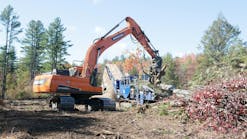Throughout its 400-year-plus history, the city of Hampton, VA, has stood at the intersection of some of the most pivotal moments in United States history. Tucked on the southeastern end of the Virginia Peninsula, the city was among the first in the state and was home to the first continuous English-speaking settlement. It also played critical roles in the Revolutionary and Civil Wars, and Langley Air Force Base—from which many air campaigns originated during the Vietnam War—remains a center of military aviation training, research, and development. Fort Monroe in Hampton is named after James Monroe, the fifth president of the United States.
Now, the city of more than 137,000 residents stands along with others in the region on the precipice of a totally different kind of history, but nonetheless equally as significant. The Hampton Roads Sanitation District unveiled in May 2018 a research center to recharge the Potomac Aquifer. The ambitious goal of the project is to slow saltwater intrusion and land subsidence in the region that includes Hampton, Newport News, Norfolk, and several other cities.
Like the military battles in which Hampton played an important role in earlier generations, this particular fight is rife with urgency, complications, and consequences that could have a profound impact on the region, and perhaps on the entire country. If the model works, perhaps more coastal cities facing challenges relating to land subsidence and sea level rise can stem the worrisome trend. New Orleans is the only other metropolitan area in the US facing a more serious threat from rising sea levels and land subsidence.
“SWIFT requires some geological features to be fully successful that are location specific—a confined thirsty aquifer being the primary requirement,’’ says Ted Henifin, general manager of SWIFT. “But large-scale success with a carbon-based process—eliminating the need to deal with a waste brine stream—opens the possibility of recycling wastewater throughout the country.”
A Growing Concern
In Virginia and other coastal communities, there is a growing urgency to act expeditiously in trying to truncate sea level rise. The sea level around Hampton Roads is 14 inches higher than it was in 1950, according to the National Oceanic and Atmospheric Administration. SeaLevelRise.org, an organization dedicated to raising awareness and working with officials to fight sea level rise, finds the pace has quickened in Virginia. “Its speed of rise has accelerated over the last ten years and it’s now rising by one inch every four years,’’ the group notes on its website.
Rising sea levels have a dramatic impact on coastal communities. According to Sea Level Rise, there are more than 45,000 properties at risk from tidal flooding in Virginia. Important military bases—the region is home to several key United States defense systems—are also at risk. The organization says the state is planning to spend more than $4 billion in sea level rise solutions, including stormwater and sewage system protection projects.
Sea level rise is not the only cause of land subsidence. Water overuse has also contributed to the sinking of land. In December 2017, Virginia reached agreements with 14 large users of municipal water in the eastern region of the state to protect coastal aquifers from depletion. From 1982 to 1995, the land had dropped 50.2 millimeters in Suffolk and 24.2 meters in Franklin, two communities in the Hampton Roads region. International Paper, which is based in Franklin, held a permit to withdraw up to 1,173 million gallons per month of groundwater before it scaled back operations in 2008. The agreements reduced the allowable withdraw of water by 69 million gallons per day.
“By embracing practical, forward-looking solutions to reduce withdrawals, improve efficiency, and develop alternative water supplies, we are laying the groundwork for sustained and sustainable success,” said Governor Terry McAuliffe.
The Hampton Roads region has also seen a dramatic increase in population, further increasing the stress on the Potomac Aquifer and groundwater. In 1950, according to US Census data, the region was home to about 446,000 residents. By 2016, the population had soared to more than 1.7 million people. Virginia Beach, which had fewer than 8,100 residents in 1960, was estimated to have more than 450,000 residents in 2016.
“The combination of sinking land and rising seas helps explain why the southern Chesapeake Bay region displays the highest rate of relative sea level rise on the Atlantic Coast, with Hampton Roads following only New Orleans as the second largest population center at risk of the negative economic, environmental, and human health impacts of sea level rise,’’ SWIFT says on its website.
Replenishing the Potomac Aquifer
The SWIFT project is one of the solutions in Virginia that is being used to address sea level rise and land subsidence. The $25 million research center opened in May on the grounds of the Nansemond Treatment Plant in Suffolk and will pump one million gallons of SWIFT water (water treated to meet drinking water quality standards) into the Potomac Aquifer.
The goal of SWIFT is to build the first full-scale facility by 2020, and four more by 2030, to recharge the aquifer with more than 100 million gallons each day of SWIFT water by 2030. The total output from each facility will range from 9 to 45 million gallons per day.
“This is a great project because 90% of what we currently discharge will no longer go into the Chesapeake Bay,’’ says Henifin. “It will be treated, purified, and put into the ground where it can provide other benefits.”
Residents of Hampton Roads send approximately 150 million gallons of water to the Hampton Roads Sanitation District (HRSD) treatment plant each day. The SWIFT project takes highly treated wastewater—which would otherwise be discharged into the Elizabeth, James, and York Rivers—and through additional advanced water treatment, produces drinking-quality water. The SWIFT water is then treated to match the existing groundwater chemistry and added to the Potomac Aquifer.
When wastewater enters an HRSD treatment plant, it first flows through a bar screen that removes large floating objects such as trash, sticks, and rags. The captured material is disposed of in a landfill, and the wastewater flows to a grit chamber and a sedimentation tank. These devices slow the flow of the water and allow sand, grit, human waste solids, and other small particles to settle to the bottom. These solids are then removed along with any scum or grease floating on top.
The wastewater then travels to secondary treatment facilities that speed up the processes of nature, allowing microorganisms (bacteria and other organisms) to consume 80 to 90% of the organic matter or human, animal, and plant waste.
The most commonly used secondary treatment technique in HRSD plants is the activated sludge process. The process speeds up the work of the microorganisms by pumping oxygen-rich air and sludge into close contact with the wastewater in an aeration tank. Over several hours, the organic matter is broken down into harmless by-products.
The wastewater is then sent to a final clarifier, where the microorganisms that grow during the activated sludge process sink to the bottom and are recycled back to the aeration tanks, and the remaining water moves on to the final treatment process.
Advanced treatment systems remove additional pollutants such as nutrients, heavy metals, and chemical compounds. These systems may use microorganisms that differ from those in secondary treatment, additional chemicals, or an effluent filtration system. This significantly increases plant construction and operation costs but improves the final quality of HRSD’s treated water.
Finally, the water is disinfected. Some wastewater treatment plants use chlorine, while others expose the water to high levels of ultraviolet light. HRSD facilities remove excess chlorine before discharging the cleaned water to local rivers. These processes kill 99% of disease-causing pathogens such as bacteria and viruses. That step allows the water to support the intended use of the area waterway so it can be released back into the environment.
Pump Stations Drive the Process
Two underground pump stations and a number of vaults are key parts of the process. The vaults and pumps are protected by channel frame doors manufactured by The BILCO Company of Connecticut. The doors are frequently used in exterior applications where there is a concern of water or other liquids entering the access opening.
The aluminum doors feature stainless steel hardware and engineered leaf assistance. They come in standard single- and double-leaf sizes, and can also be specified to meet unique access requirements. The doors are also constructed with corrosion-resistant materials and include hold-open arm locks to ensure safe egress and a heavy-duty and positive latching mechanism to prevent unauthorized access. The doors have a 25-year warranty.
“The doors met the quality and specifications that we needed for this job,’’ says Chris Robards, project manager for Crowder Construction, the company that constructed the research center. “They’re quality doors and we install them in a lot of jobs. It has to be easy to operate. These particular hatches are easy to open and close.”
There are seven doors protecting the valves and pumps in the sophisticated system, along with three LadderUP Safety Posts, also manufactured by BILCO. The posts provide easier, safer access through floor doors, roof vents, and manholes. Two BILCO roof hatches were also used in the project. Marcor Associates of Midlothian, VA, delivered the doors, hatches and safety posts. Crowder Construction and Hazen and Sawyer served as general contractors on the project.
No Easy Answers
Fighting sea level rise is a costly, complicated process. Virginia is not the only state where communities are seeking answers. Sea level has risen 10 inches in South Carolina since 1950, according to SeaLevelRise.org, and the sea level along the coast of Florida has risen 8 inches in the same time frame. States along almost the entire border of the Atlantic Ocean and southern states such as Mississippi, Louisiana, and Alabama have communities threatened by sea level rise.
Therefore, it is critical that communities, government, and residents work together to implement steps that could halt saltwater infiltration and slow land subsidence. The SWIFT project is one of the innovative measures that could have profound consequences for years to come—and maybe even protect compelling parcels of the nation’s rich history.
“A reduction or complete halt of subsidence would provide years of added use of highly valuable developed land impacted by sea level rise,” SWIFT says on its website, “as well as protect thousands of acres of environmentally valuable wetlands from complete inundation.”





